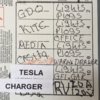I'm was also skeptical about needing to upgrade our 200A Main Service Panel ("MSP") but because of the number of circuits and multiple loads on our existing 3,300 sq. ft. 2007 new construction 2-story single family home's 200A MSP and 100A subpanel we've ALREADY had to:
1. Load Calc (attached)
2. repurpose our unused 240V electric dryer circuit
3. double up every available breaker
... just to install our Tesla High Power Wall Charger (100A breaker / 80A max.)
This was verified by 3 electricians for our Tesla HPWC installation and subsequently SCE + 3 solar company quotes last year. SCE even suggested we may just want to upgrade to a 400A panel since they'll provide the additional 200A wiring at no charge... and 400A would provide plenty of future capacity for adding another EV, additional solar, another garage, etc.
The reason our 200A MSP is completely full is because the original tract home contractor only installed a cheap 200A MSP with very few breaker slots. Even before we added our Tesla, RV, and outdoor kitchen the original builder had to add a 100A subpanel just to feed the original circuits.
Obviously I'll take another look at this hard if we add solar and Powerwall(s) but please trust me that I've gone over this several times and concluded we need a MSP upgrade if we add solar... especially since we'll get a 30% tax credit and need more breakers anyway. Plus in the "big picture" the cost of upgrading our MSP to provide more amperage and breakers is incremental when adding 7kW solar.
I just posted to complain, not to offer advice. I don't know why electricians insist upon installing super-small breaker boxes with very few breaker slots when:
- The price of larger boxes with more breaker slots is usually the same, if not cheaper. (Almost no one buys smaller (by slot count) boxes any more from many suppliers, so the bigger boxes have the economies of scale and shorter inventory times delivering lower costs. Electricians are probably installing smaller slot capacity breaker boxes just because they remember they used to be cheaper 10 to 20 years ago, but didn't check today's prices. So, it's not only "least cost" but also "most outdated" and "most stupid". Cheap really does buy into bad.)
- The price of home consumer regular full size breakers for bigger boxes is way lower than the price of the same home consumer slim breakers for smaller boxes. The price of the 2 or 3 most expensive slim breakers in a small breaker box is often more than the entire cost of a large breaker box, and the price of the large size non-slim breakers for the high slot number breaker boxes are often almost free, or only a few bucks plus or minus, and less than half the cost of the slim breakers on average.
- The entire industry is going toward super-large number of breaker slots. This is because microwaves, TV's, computers, NEC, CAFCI, solar, smart homes, and I probably forgot a few things.
I can see how in 2007 it seemed that they got in "just under the gun" of the introduction of CAFCI requirements and were able to "save a lot" that way, but it was short sighted. Today, the code wants more dedicated circuits, not less. Today, we use electricity for more of our life, not less. Both those things were true years ago, too. Now, we add to that EV, Solar, and batteries. Solar was already a big thing a decade ago. Today, someone trying to skimp on boxes still irks me.
This seems to be a common problem. With EV's, flying electric cars, solar panels, computers, virtual reality holodecks, AI supercomputers, PowerWalls, and further down the road than all of those things, converting our home heating from gas to electric (yes I think that's coming after virtual reality holodeks and flying electric cars become common, and I think it is coming because it is an anti-dirty fossil fuel goal to eliminate it), we are going to need more panel slots and electricity capacity in the electrical systems of the next 10 to 30 years, not less. Requiring homeowners to purchase panel upgrades of $2K - $5K every decade just because of a lack of foresight bothers me. But, they're not my homes, so there's that. I can see doing 1 or 2 panel upgrades every 50 or 100 years in the coming era, but having to replace a decade old panel just seems like someone dropped the ball.
When someone installs a pool, or solar system, or EV charger, or a PowerWall, or something, one of those things often triggers a panel upgrade. I always think that's an opportunity to avoid the next panel upgrade 10-30 years down the line, and ask them to over-spec it.
However, if SCE said you can get 400A wiring for free, in the general case, that sounds pretty sweet (although in the specific case of your home I advise against anyone seeking advice from me since I don't know their particulars and I'm not an electrician). I asked for 400A here to my solar installer when upgrading our 110A panel, and he said PG&E frowns on that because it triggers many issues (reviews, delays, interactions, etc.) and they could deny it or take forever, so he said we should just go to 200A to get it done within months rather than in the following year. Now whenever we dry clothes and charge my car, the PG&E supply drops by 15 to 20 volts, because PG&E delivers such a small physical supply to our home. That keeping the 400A upgrade down to a 200A upgrade really helped us quickly get that installed without the right kind of upgrade from PG&E.




